MARIANI’S
May 29, 2005
NEWSLETTER
"Le Dejeuner sur L'Herbe"
(1862-3) by
Eduoard Manet
WEB SITE: To
go to my web site, in which I will update food
&
travel information and help link readers to other first-rate travel
& food sites, click on: home page
ACCESS TO
ARCHIVE: Readers may now access
an
Archive of all past newsletters--each annotated--dating back to July,
2003, by simply clicking on www.johnmariani.com/archive
.
NEW
FEATURE! You may now subscribe anyone you wish
to this newsletter by
clicking here.
~~~~~~~~~~~~~~~~~~~~~~~~~~~~~~
~
NEW YORK CORNER: Felidia by John Mariani
QUICK BYTES
~~~~~~~~~~~~~~~~~~~~~~~~~~~~~~ ~
NEW YORK CHEESECAKE—LIKE, THERE’S SOME OTHER KIND?
by John Mariani

I’m trying to think of something better.
Roast beef with mashed potatoes? Turkey with stuffing? Lobster with clarified butter? Pork BBQ with cole slaw? All wonderful examples of American food at its very best. But I’m having a hard time topping the idea that a slice of New York cheesecake and a cup of strong coffee is the best combo in the world.
And it’s at its very best as a solitary pleasure, eaten when you’re alone, not watching TV or pondering the universe, but alone with the slice of cheesecake on a nice plate with a mug of freshly brewed—preferably percolated--java sweetened with sugar and cream.
Since the cheesecake has only the faintest aroma of vanilla and lemon, the steaming coffee must take up the slack, sparking a rush of warm familiarity in the nose, preparing the palate for the first morsel of the cake, which is enjoyed as slowly and with as much sheer pleasure as a Tsar would savor his beluga caviar from a silver spoon. No one eats cheesecake fast, no one gulps it down. It’s too rich, and its glory is in the way it changes texture from cool and thick to creamy, smooth and warm on the tongue. Another sip of coffee, another little morsel of the cake, and you can spend ten minutes of bliss thinking of nothing but what you’re enjoying.
Hardly surprising, then, that long-legged pin-ups like Betty Grable (above) have been called “cheesecake” since the 1930s.
Cheesecake as we know it is more or less an invention of New York restaurants. On the one hand, Italian-American restaurants introduced a version of ricotta cheesecake based on the Southern Italian models back in the 1930s. Jewish-style cheesecakes, first made with cottage cheese but later with cream cheese, predominated in New York delis and later at steakhouses. But one thing at a time.
There are a few—very few—references to some sort of cheese-based cake or tart dating back to the ancient Romans in the second century B.C., though no actual recipe for a cheesecake has been found before the Fourteenth Century A.D. In the Middle Ages cheese was baked into savory tarts by wealthy families that could afford the outrageously expensive spices like cinnamon, allspice and nutmeg mixed into such festive confections. Sugar, also very expensive, was introduced by Arab traders to Sicily and Southern Italy, where pastry making became an art form and the first Italian pastry cooks’ guild was founded in 1492).
When sugar became cheaper and more available, sweetened cheese confections became part of the tradition of the Easter feast, and it was in Naples that the forerunner of all Italian cheesecakes began with an Easter torta called pastiera, made with a wheatberry crust, ricotta, and colorful candied fruit. The idea soon flourished throughout Europe and the Mediterranean, so that Greeks, Germans, and French adapted their own versions. Russians eat a Easter dessert called sirnya pascha, made with farmer’s cheese in a decorative mold (below)
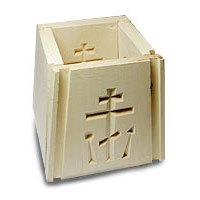 , that is a dead ringer for pastiera but without
a crust;
instead they spoon it onto a sweet bread kulich, itself a
close cousin
to the Italian Easter bread called panettone.
Neapolitan and Sicilian immigrants—by the
millions--brought the idea of the Easter ricotta cheesecake to New
York, but it
became so popular that pastry shops and restaurants made it into a
year-round
staple, which it still is today.
, that is a dead ringer for pastiera but without
a crust;
instead they spoon it onto a sweet bread kulich, itself a
close cousin
to the Italian Easter bread called panettone.
Neapolitan and Sicilian immigrants—by the
millions--brought the idea of the Easter ricotta cheesecake to New
York, but it
became so popular that pastry shops and restaurants made it into a
year-round
staple, which it still is today.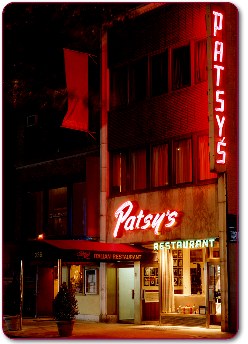 The
best Italian-style cheesecake I’ve found in New York is at Patsy’s Restaurant
in the Theater District, which has been around for six decades and was
Frank
Sinatra’s favorite restaurant. “We used
to make our own cheesecake,” says owner Joe Scognamillo, “but we just
couldn’t
find the quality of ricotta we used to get—not too thick, not too moist. But we did find one Italian baker in New
Jersey who makes fabulous ricotta, so now he makes our cheesecakes just
the way
they were since we opened in 1945.” Patsy’s
is indeed the paragon of Italian-style
cheesecakes, well scented
with vanilla and lemon rind, with a luscious, never viscous texture. It
goes
very well with a cup of perfectly rendered espresso at Patsy’s.
The
best Italian-style cheesecake I’ve found in New York is at Patsy’s Restaurant
in the Theater District, which has been around for six decades and was
Frank
Sinatra’s favorite restaurant. “We used
to make our own cheesecake,” says owner Joe Scognamillo, “but we just
couldn’t
find the quality of ricotta we used to get—not too thick, not too moist. But we did find one Italian baker in New
Jersey who makes fabulous ricotta, so now he makes our cheesecakes just
the way
they were since we opened in 1945.” Patsy’s
is indeed the paragon of Italian-style
cheesecakes, well scented
with vanilla and lemon rind, with a luscious, never viscous texture. It
goes
very well with a cup of perfectly rendered espresso at Patsy’s.Meanwhile the development of Jewish-style cheesecake had to wait for the availability of cream cheese and, to a certain extent Graham Cracker cookies. Fresh, that is, unaged, cheese spoiled quickly and was not easily shipped outside of a region until refrigerated railway cars came along. Isaac and Joseph Breakstone began producing a packaged fresh cheese they called “Breakstone’s Downsville Cream Cheese” (named after the New York community where it was produced) in 1920, quickly becoming a favorite with New York Jews, who used it as a spread for bagels.
Then, in 1928 the Empire Cheese Company of South Edmeston, NY, contracted to produce a cheese made with cream and milk by a dairyman named Lawrence and called it “Philadelphia Brand” cream cheese (now a trademark of Kraft Foods).
 These two
brands made cream cheese readily available, and soon Jewish bakers were
switching from moist cottage cheese to cream cheese to make their cakes. And Breakstone’s was the basis for a
cheesecake that became the template for all Jewish-style cheesecakes to
These two
brands made cream cheese readily available, and soon Jewish bakers were
switching from moist cottage cheese to cream cheese to make their cakes. And Breakstone’s was the basis for a
cheesecake that became the template for all Jewish-style cheesecakes to
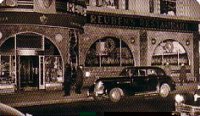 follow
when Reuben’s (left),
a deli restaurant opened in 1908 on Park Avenue by a
German
immigrant and later moved to East 58 Street, where it
became
famous for its overstuffed sandwiches named after celebrity guests, and
its exceptionally
rich cheesecake made with Breakstone’s, whole eggs and cream on a
cookie crust. Sadly, Reuben’s closed in
1966, but its
cheesecake is still legendary. Don’t get a Jewish comedian
started on
Reuben’s.
He’ll do ten minutes of schtick on it.
follow
when Reuben’s (left),
a deli restaurant opened in 1908 on Park Avenue by a
German
immigrant and later moved to East 58 Street, where it
became
famous for its overstuffed sandwiches named after celebrity guests, and
its exceptionally
rich cheesecake made with Breakstone’s, whole eggs and cream on a
cookie crust. Sadly, Reuben’s closed in
1966, but its
cheesecake is still legendary. Don’t get a Jewish comedian
started on
Reuben’s.
He’ll do ten minutes of schtick on it.FREE BONUS JOKE: A guy goes to Reuben's for breakfast, calls over the waiter and says, "Gimme two boiled eggs -- one of them so undercooked it's runny, and the other so overcooked it's tough and hard to eat. Also, gimme some grilled bacon that's really cold and greasy, burnt toast, butter so hard it's impossible to spread, and a pot of very weak, cold coffee."
"That's a complicated order sir," said the bewildered waiter. "It might be quite difficult."
The guest replied, "Oh, really? I don't understand--that's what I got here yesterday!" Ba-da-boom!
Reuben’s claimed that a rival restaurant on Broadway, named Lindy’s (below)--which Damon Runyon immortalized in his stories as “Mindy’s”--stole their recipe and made it famous as
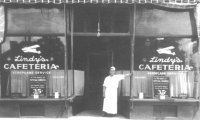 “Lindy’s New York
Cheesecake,” baked on a cookie crust and with a filling containing
grated lemon
and orange rind and vanilla. The original Lindy’s
restaurants are gone, though the name was bought by the Riese
restaurant company, which
still runs
three locations in New York and serves the original recipe—which, in
any case,
was long ago published.
“Lindy’s New York
Cheesecake,” baked on a cookie crust and with a filling containing
grated lemon
and orange rind and vanilla. The original Lindy’s
restaurants are gone, though the name was bought by the Riese
restaurant company, which
still runs
three locations in New York and serves the original recipe—which, in
any case,
was long ago published.Graham Crackers came out in 1882, the outgrowth of the very successful Graham flour developed by Rev. Sylvester Graham, a vehement temperance advocate who believed his flour cooled lustful passions. Nabisco Honey Grahams became the base for Florida’s Key lime pies and also an alternative to the cookie crust of Jewish-style cheesecakes, which were already being popularized by New York steakhouses, where ending a meal with a slice is still as much a part of the New York steakhouse experience as gorging on a tomato salad, grilled sirloin or porterhouse, creamed spinach, and cottage fried potatoes.
One of the most famous of the New York steakhouses was, and still is, the Palm (now with 28 U.S. locations), which opened as a speakeasy on Second Avenue in 1926, immediately drawing a raffish clientele of guys on both sides of the law, with a significant wedge of newspapermen in the middle—many of whose caricatures are painted on the Palm’s walls. The cheesecake served at the Palm has been on the menu since 1965, but you won’t find the recipe in The Palm Restaurant Cookbook; indeed the owners refuse to divulge where their famous cheesecake comes from, even though it’s the worst kept secret in the world: Everybody knows The Palm gets its cheesecake from S&S, a bakery in the Bronx, and it’s become so much a part of New York food culture that just about every other steakhouse in New York—and nationwide chains like Morton’s, Don Shula’s, and Ruth’s Chris—serve the same S&S cake.
German cheesecake, when you can find it in New York, is closer to the Jewish original made with cottage cheese, which is similar to the German cheese named quark (in Austria, topfen), pronounced “qvahrk,” a tangy curd cheese made from skimmed milk. If cream is mixed in—essential for a cheesecake—it is called Rahmfrischekäse, which in fact means “fresh cream cheese.” Once you could find a quark cake in the numerous bakeries of Yorkville on the upper east side of Manhattan, previously a heavily German neighborhood, but they are all gone. Today you can still find quark cheesecake at
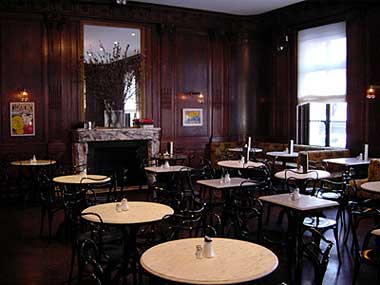 Yorkville’s Café
Sabarsky
(left) in the Nueue Gallerie,
a small museum devoted to German and Austrian
art.
Yorkville’s Café
Sabarsky
(left) in the Nueue Gallerie,
a small museum devoted to German and Austrian
art.As for French cheesecakes, they are a total misnomer. I asked one of New York’s finest pastry chefs, François Payard, of Payard Patisserie & Bistro, if he does a French-style cheesecake, and he shrugged and said, “No, because it really isn’t a French pastry.” The French of course do make savory quiches with cheese, but the occasional reference to “French cheesecake” is usually just a marketing term for a very creamy, light style with more of a chiffon pie texture and perhaps a sour cream frosting.
Frankly, I don’t want to think about the adulterations that cheesecakes have gone through, topped with cloyingly sweet fruits in syrup or with chocolate swirled into the mix.
 A few fresh, ripe
strawberries
or blueberries is all right with me, but I think of such additions the
way I do
of destroying the perfect marriage of ingredients on a basic
pizza—nothing can
improve the holy trinity of tomatoes,
mozzarella, and basil on a thin, bubbly, charred crust.
A few fresh, ripe
strawberries
or blueberries is all right with me, but I think of such additions the
way I do
of destroying the perfect marriage of ingredients on a basic
pizza—nothing can
improve the holy trinity of tomatoes,
mozzarella, and basil on a thin, bubbly, charred crust.The very simplicity of a good cheesecake is its greatness, along with the homey, happy look of it, with its light, golden-brown top sliced through to reveal an interior the color of fresh cream. The crust barely matters.
 And
that is why eating a slice of New York cheesecake and sipping a cup of
hot coffee
is always satisfying each and every time.
And
that is why eating a slice of New York cheesecake and sipping a cup of
hot coffee
is always satisfying each and every time.
Junior's Brooklyn Cheesecake
Fortunately you can mail order some of the best New York cheesecakes, which usually come frozen—and which re-freeze very well indeed—by overnight delivery, which is a good thing, because once seized with a desire for a cheesecake, it’s not something you can put off for long. (See box below.)
Someone once defined eternity as “two people and a ham." But when I think about it, heaven might well be defined as a piece of cheesecake, coffee, and me.
Junior’s—Junior’s has a bakery branch in Grand Central Terminal. To order a Jewish-style cheesecake, first check Junior’s web site: www.juniorscheesecake.com, which offers several kinds of flavored cheesecake in addition to the plain original. Call 718-852-5257.
S&S—The great
NEW
YORK CORNER
by John Mariani
Felidia
Ristorante
243 East 58th Street
212-758-1479
A quarter century
in business is an extraordinary feat for any restaurant, but for
one to be at the top of its game, and constantly improving after all
that time, is true testament to the dedication of its owners and its
entire staff. When Lidia and Felice Bastianich opened Felidia 25
years ago, it was immediately one of the most beautiful Italian
restaurants in NYC, not another copy of some trattoria in Milan, with
the clichés of white walls, dark wainscoting, and bad artwork.
Instead
Felidia had old brickwork, archways, fine furniture, and good artwork,
along with a terrific bar (left)
up front, and a display of antipasti at the end of it.
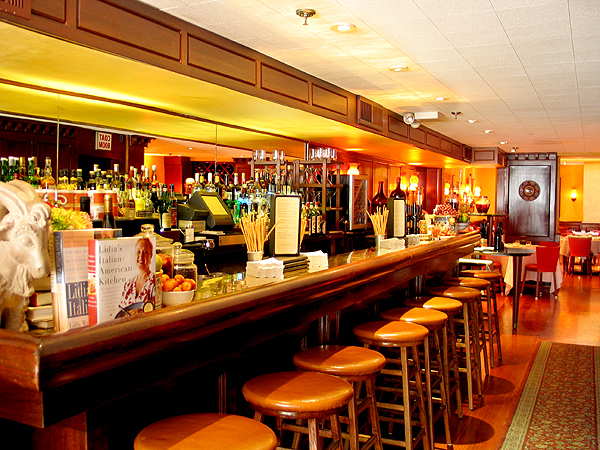 Time has only improved Felidia's looks, which
have been updated in recent years to a more modern polish, but its
basic lineaments still have the ideal mixture of sophistication and
warmth, which is what you get from Lidia Bastianich herself,
Time has only improved Felidia's looks, which
have been updated in recent years to a more modern polish, but its
basic lineaments still have the ideal mixture of sophistication and
warmth, which is what you get from Lidia Bastianich herself, 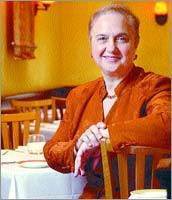 and, since she separated from her husband a
few years ago, from her daughter on duty, Tanya. Lidia (right), of course, is well known
for her PBS-TV show--which I think is the
best cooking on show the tube by far--and her numerous cookbooks, and
she is one of the smartest, savviest, and most authoritative people in
the
business. She and her son Joseph are involved with other
restaurants, including Becco in NYC, and two Lidia's restaurants in
Kansas City and Pittsburgh. She has never compromised on
ingredients, and, though she has had very few chefs over the year in
her kitchen, they have all been allowed their own creativity within the
general tenor she has set here to be expressive of the cuisine of her
own childhood in Istria. The current kitchen occupant is the formidable
Fortunato Nicotra, and he cooks with a steady, vigorous gusto evident
in every dish.
and, since she separated from her husband a
few years ago, from her daughter on duty, Tanya. Lidia (right), of course, is well known
for her PBS-TV show--which I think is the
best cooking on show the tube by far--and her numerous cookbooks, and
she is one of the smartest, savviest, and most authoritative people in
the
business. She and her son Joseph are involved with other
restaurants, including Becco in NYC, and two Lidia's restaurants in
Kansas City and Pittsburgh. She has never compromised on
ingredients, and, though she has had very few chefs over the year in
her kitchen, they have all been allowed their own creativity within the
general tenor she has set here to be expressive of the cuisine of her
own childhood in Istria. The current kitchen occupant is the formidable
Fortunato Nicotra, and he cooks with a steady, vigorous gusto evident
in every dish.
The wine list is one of the best in NYC,
though it is certainly not cheap.
When you sit down at the well-set table,
you'll be served a basket of warm focaccia and breads, together with a
mild bean puree. The you hear the specials of the evening, often from
Lidia if she is on the premises. There are tasting menus that
begin at $75 (wine may be added to the tab); otherwise antipasti run
around $12-$18, pastas (as full courses) $20-$28, and main courses
$24-$34.
The antipasti are many, from lustrous
prosciutto sliced thin to cannellini and chickpeas, mushrooms and
peppers in olive oil, to glistening mozzarella. Soups should
never be neglected here (often afterthoughts in Italian restaurants),
like la zuppa di cappone,
capon soup of rich, deep flavor with
Parmigiano-and-breadcrumb dumplings with spinach. Crispy
sweetbreads with roasted cauliflower is deliciously dressed with a pignoli-raisin-caper sauce.
Pastas are, each and every one, among the best in NYC, textbook
examples (she wrote the
textbooks!) of perfectly cooked whole wheat bigoli with broccoli di
rabe, garlic and oil, a touch of tomato, smoked ricotta, and aromatic
anchovies. Lovely gnocchi come with whipped baccalà and Grana Padano
cheese, while Nicotra may one night fill his ravioli with pear and
fresh pecorino, sautéed with crushed black pepper. My very
favorite--ever since Felidia opened---is krafi, an envelope-shaped
Istrian pasta with three cheeses and filled with citrus rind and rum,
sauced with a roast veal sugo--magnificent!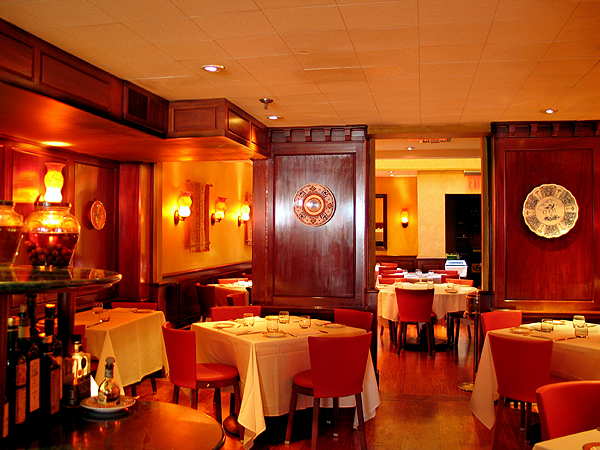
I like simple main courses at
Italian ristoranti, but Felidia's are pretty lavish, from quails
stuffed with farro, mushrooms, and shallots, then glazed with vinegar
and served with potatoes and roasted endive. No one makes a better
classic like seared calf's liver with onions, vin cotto, polenta, and farro, and if you love tripe, have
it here, braised with Savoy cabbage and beans--a very heavy dish
indeed, but wonderful on a cold evening. Braised beef shank takes
on the sweetness of prunes, while wild striped bass is poached in a
tomato-mushroom broth. I will always be happiest with whole
grilled branzino with
oranges, fennel, and an olive salad.
For dessert go with anything--the
sweets here are all quite well rendered, both the expected
tiramisù and
cheesecake and the less familiar fruit tarts and cakes. Gelati and sorbetti are also excellent.
There's nothing to make me think that in
twenty-five years I wouldn't be writing exactly the same thing about
Felidia, for even if I have to be wheeled into the dining room, I know
that the krafi will still taste the same, the waiters will know my
name, the wine will be at the perfect temperature, and Lidia will still
want to know if I was completely pleased.
RESTAURANTS
101:
NEVER HAVE A COMPLETE IDIOT ANSWER YOUR PHONE

While on
location for the movie "It's All True" in Austin, Texas, Sandra
Bullock (who lives there), Gwyneth Paltrow, and
Kevin Kline
called to make a late dinner at the restaurant Mansion at Judge's Hill
but were told by an employee the kitchen would be closed, after which
the
employee was promptly fired by the owner.
WHY THERE'LL ALWAYS BE AN ENGLAND
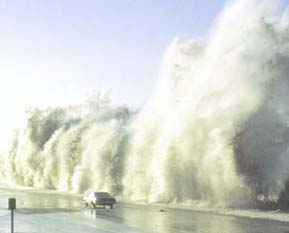
QUICK BYTES
* On June 7 a 6-Course Wine dinner will be held at
* On June 8 in
* On June 12 The Trellis in
* On June 12 The Club Culinaire of French Cuisine will hold its annual
~~~~~~~~~~~~~~~~~~~~~~~~~~~~~~~~~~~~~~~~~~~
MARIANI'S VIRTUAL GOURMET NEWSLETTER is published weekly. Editor/Publisher:
John Mariani. Contributing Writers: Robert Mariani, Naomi
Kooker, Kirsten Skogerson, Edward Brivio, Mort
Hochstein, Lucy Gordan, Suzanne Wright. Contributing
Photographers: Galina Stepanoff-Dargery, Bobby Pirillo. Technical
Advisor: Gerry McLoughlin.
Any of John Mariani's books below
may be ordered from amazon.com by clicking on the cover image.
 |
 |
 |
 |
 |
 |
copyright John Mariani 2005